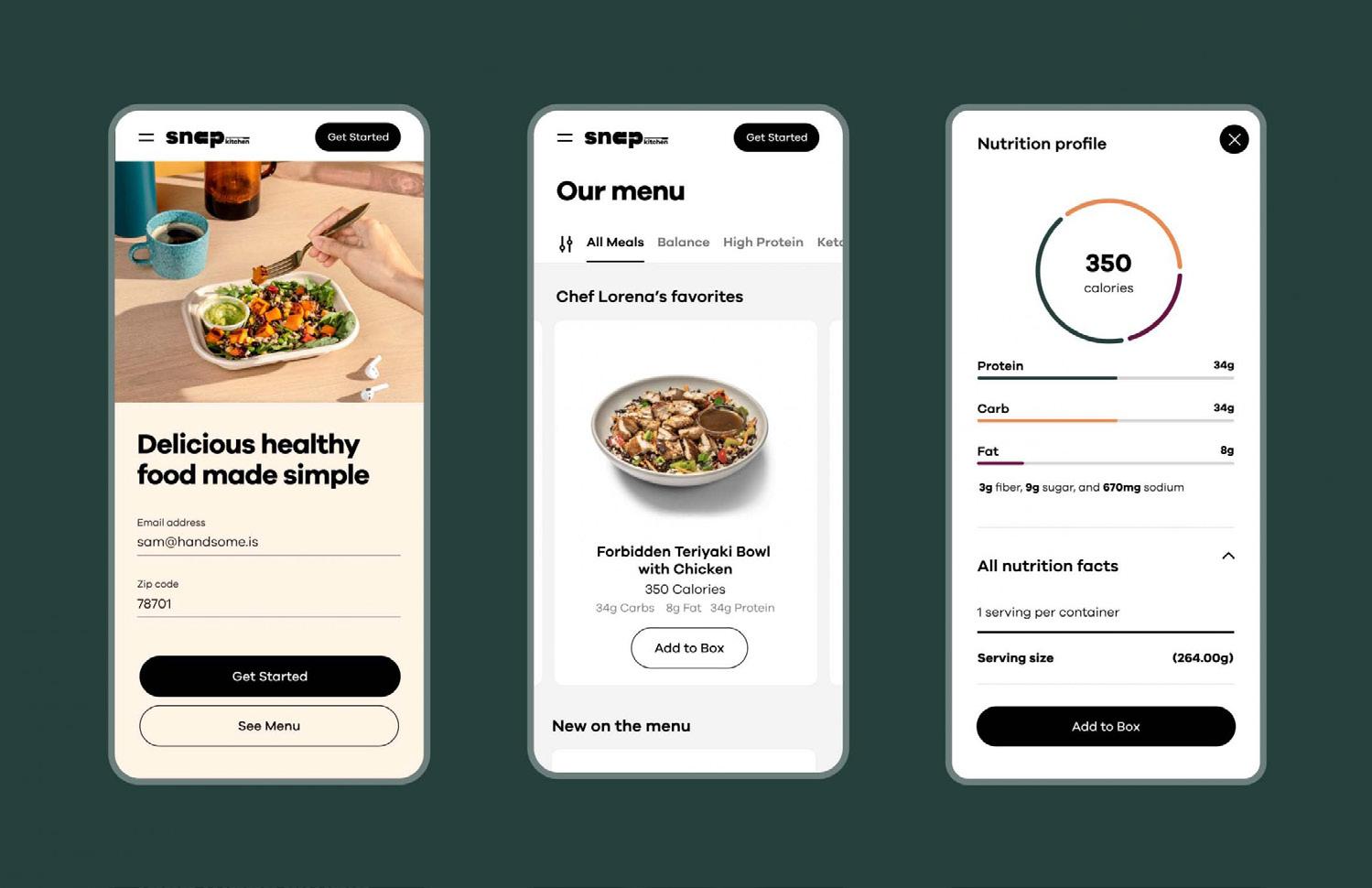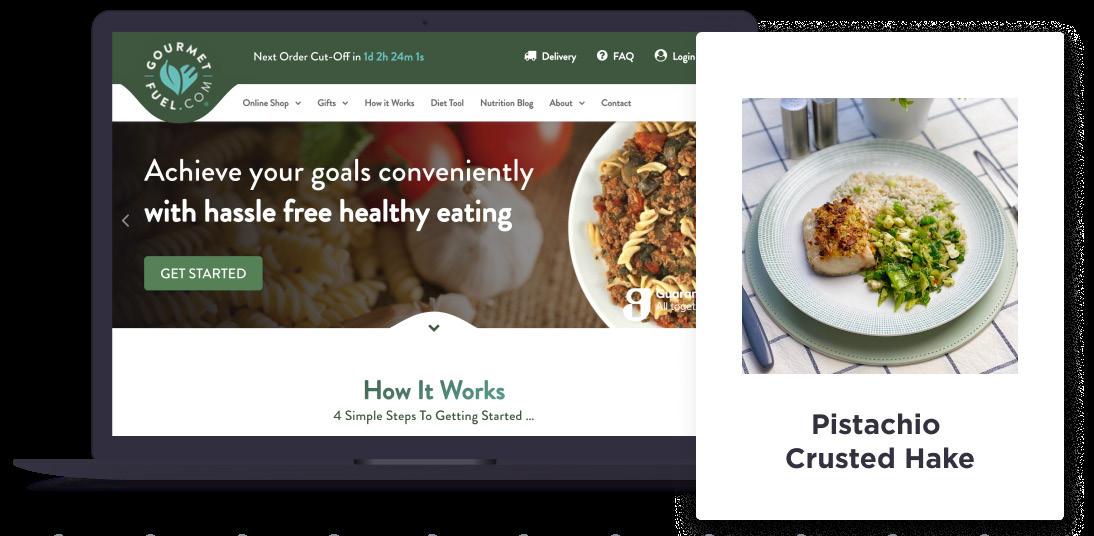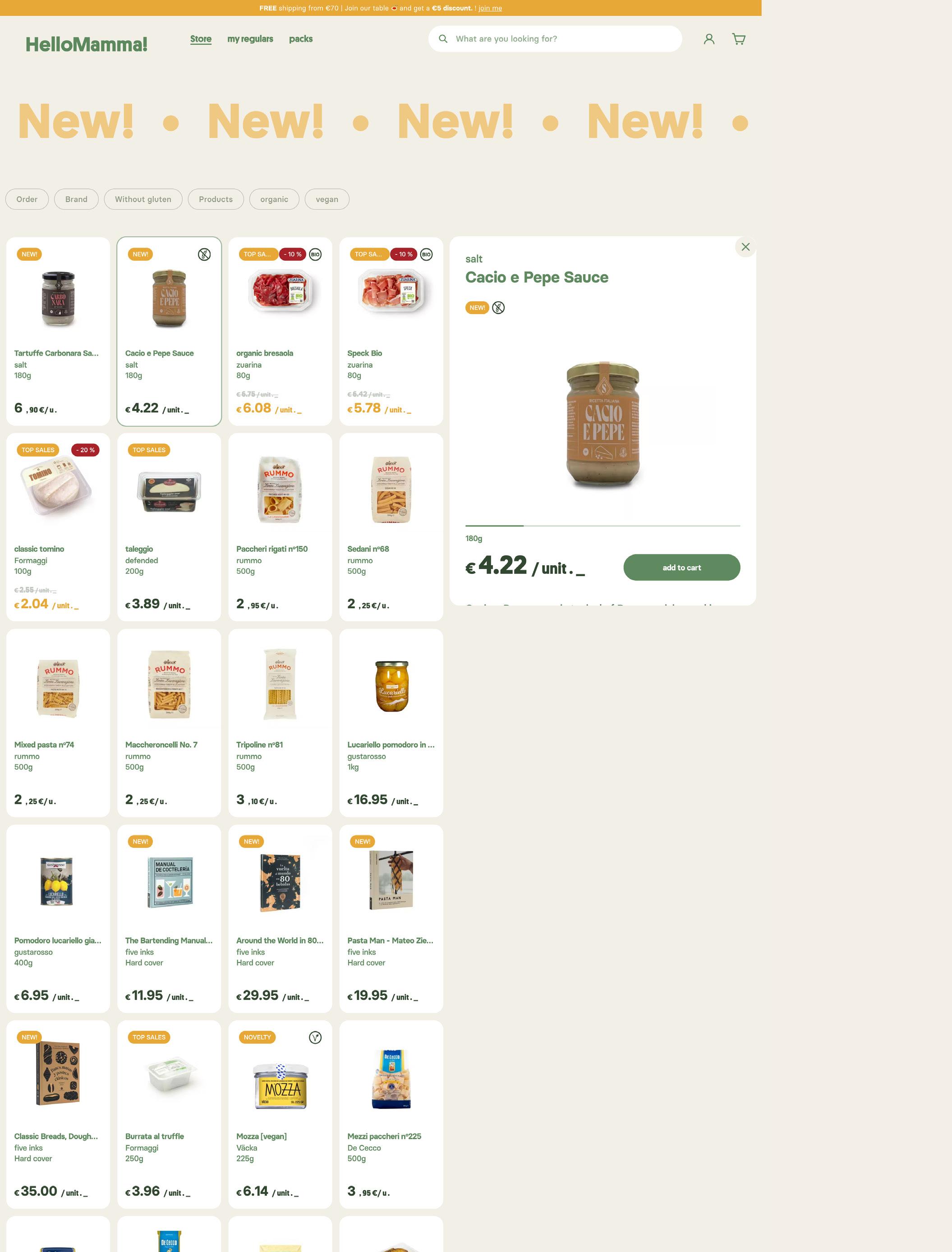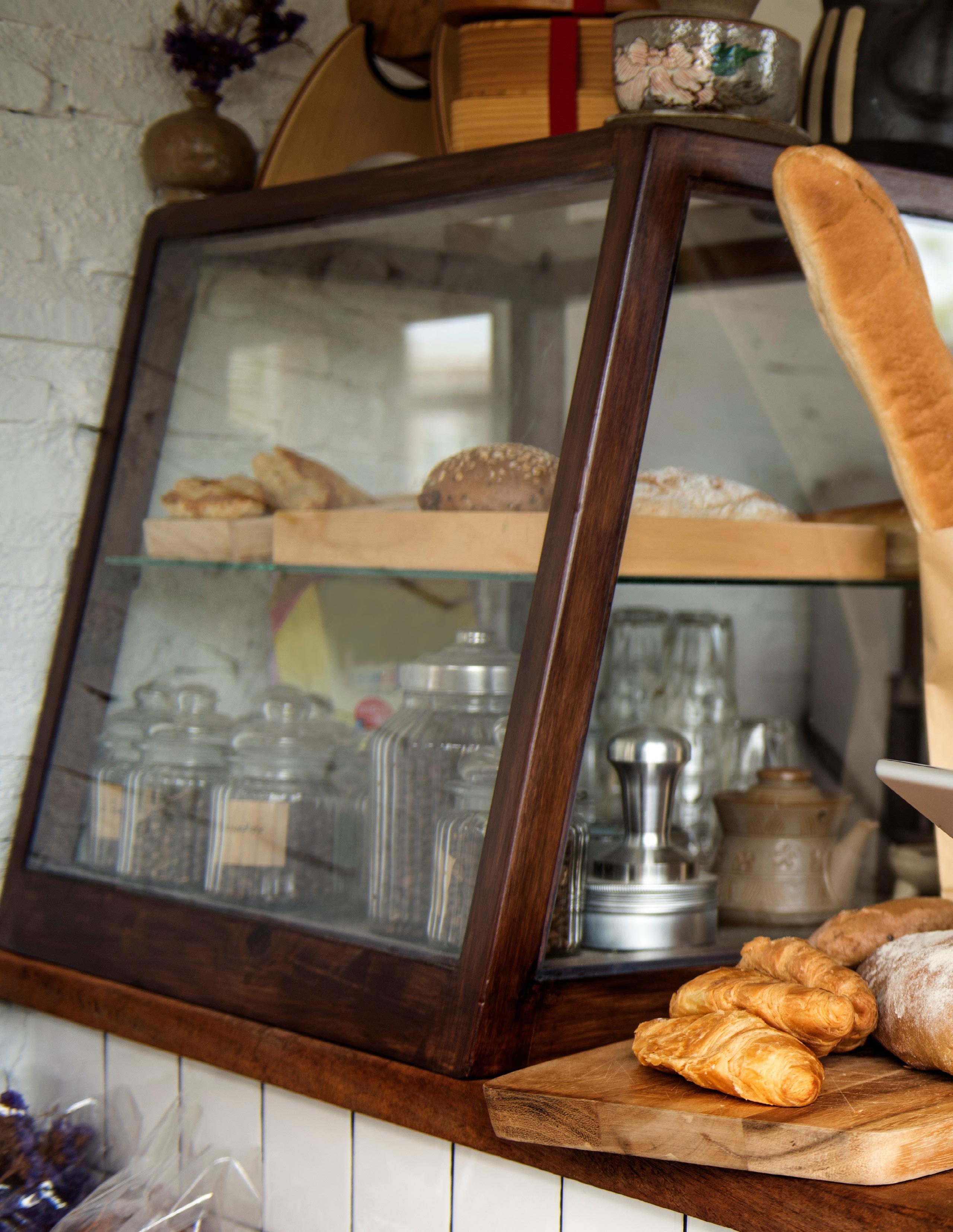




Over the last few years, the food and beverage industry has gone through one of the most rapid transformations — from barely anyone buying groceries online to shoppers ordering almost exclusively online. Even categories like alcohol and perishable foods, despite the logistical challenges, have seen increases in online sales.

Looking back at 2022, BigCommerce food and beverage merchants across the globe saw a 13% increase in gross merchandise volume (GMV) compared to 2021. By the same measure, the total number of orders increased by 8.1% yearover-year (YoY) and average order value (AOV) increased by 4.8% YoY.
It’s safe to say the old ways of shopping for food and drinks have been permanently altered. Demand from both consumers and wholesale buyers coupled with advances in ecommerce technology have taken shopping online for food and beverages from obscure to mainstream.
And yet, there’s still more opportunity for this industry’s ecommerce sales to grow. In fact, the global food and beverage ecommerce market size is expected to reach $69.77 billion in 2023 at a compound annual growth rate (CAGR) of 22.2%.

To support food and beverage brands in reaching their ecommerce goals, we’ve developed a cookbook filled with recipes for success. With insights from BigCommerce partners and other experts, this cookbook explores critical strategies to elevate your business, key features to look for in your ecommerce technology, as well as success stories from our own BigCommerce merchants.
Bonne lecture!

Your customers should be at the heart of everything you do. Make sure you’re gathering information about their preferences through surveys or interviews. You can also use tools to help support your efforts, like heat mapping to understand how visitors interact with different web pages or your ecommerce platform analytics to see which products are most popular. By taking a customer-centric approach, you can help to ensure you exceed customer expectations and build brand loyalty.
Omnichannel commerce is a must if you want to reach more shoppers. Studies show marketing across three or more channels earns 250% higher engagement, and fulfilment options like click-and-collect, also known as buy online, pick up in store (BOPIS), have grown to be some of the most popular trends in retail. To successfully execute an omnichannel strategy, you must ensure the experience is unified and cohesive at every touchpoint, so shoppers can seamlessly move through their journey with your brand — no matter where they start.
Regardless of your strategic focus and future goals, there are three golden rules to follow when it comes to selling food and beverage products online. So before jumping into specific strategies and technology features, let’s review three key ingredients that are foundational for ecommerce success.
Just because you can cut a steak with a Swiss Army knife, it doesn’t mean you should. The same applies when selecting your ecommerce technology. While an all-in-one solution may sound nice at first, they are rarely good for everything. Conversely, a flexible ecommerce platform that provides a solid foundation will allow you to integrate with the best tools for your specific needs, such as search capabilities or a custom CMS.

Now that we’ve laid the foundation, let’s dig into the specific strategies we’ve seen with our BigCommerce food and beverage merchants. From reducing complexity to growing globally, you’ll find relatable use cases along with key steps and all the necessary ingredients needed to achieve success.

MEAL PREP (STEPS TO TAKE): GATHER EVERY STAKEHOLDER IN YOUR COMPANY
In 2022, we surveyed over 4,000 consumers across the globe and found that 55% shop online at least once a week. With that many potential customers, it’s clearly time for food and beverage brands to accelerate their digital transformation efforts. Indeed, we polled some of our food and beverage merchants, and found that 7% said accelerating their business digitalisation is a strategic focus for 2023.
selling online direct-to-consumer (DTC) subscriptions.
Handsome focused on research strategy and branding to help Snap Kitchen define its target audience. To ensure the brand could stand out in a crowded space, the agency studied mental models and mapped out the customer journey. Now, wherever the customer interacts with the brand, they have a consistent and connected experience.

Japan Centre, a London brand offering high-quality Japanese products, faced a similar challenge. The brand was already selling online, but when the pandemic happened, online sales grew considerably. Unfortunately, the technologies the brand was using couldn’t keep up, and the bespoke legacy ecommerce platform became increasingly hard to maintain and develop new features on.
Merinda Taylor, Head of Digital and Ecommerce at Japan Centre, knew the brand needed to update its tech stack with more scalable solutions to accelerate and optimise ecommerce growth She looked for an agency to support the migration and provide advice and ongoing support for the new site.
Japan Centre: Accelerated Digital Transformation
Read the full story
MAIN COURSE (STRATEGIC FOCUS): PREPARE AND EXECUTE YOUR ECOMMERCE STRATEGY
THE CHERRY ON TOP (DESIRED RESULTS): INCREASED ONLINE SALES
The first place to start is with your ecommerce strategy. Focus on who your customers are, their likes and how they behave online. This will help you determine what type of tech stack — the combination of technologies necessary to build, run and improve an online store — you’ll need.
We recommend partnering with an experienced agency, particularly if you don’t have the necessary expertise on your team. Even if you do, you might still need help selecting and integrating technologies. That’s exactly what Snap Kitchen, a Texas-born brand selling prepared healthy food, did. By partnering with the agency Handsome, the brand has transformed its business and technology from selling through mostly brick-and-mortar stores to
Handsome also composed a modernised tech stack that’s designed to be strong enough to scale, flexible enough to evolve and streamlined enough for a small team to maintain. Additionally, they ensured that the BigCommerce’s ecommerce platform could integrate with Snap Kitchen’s many existing business systems — a key consideration when selecting a platform. Highlights include:
• BigCommerce for UX and product information
• Stripe for payment processing
• ShipStation for shipping management
• Klaviyo for customer relationship management
She chose the strategic agency GPMD to consult and develop longterm technical and ecommerce strategies. Under the guidance of its agency, Japan Centre chose BigCommerce to power its ecommerce back-end. The agency also helped implement complex integrations, collaborated with the front-end and UX design team, and delivered the headless back-end of their future ecommerce site.
Whether you’re planning to launch online or you’re updating your existing technology — everyone needs to be involved, or at minimum, informed. It’s a common misconception that only IT and marketing teams need to take part in a digital transformation because whatever you are going to put in place will have an impact on all your company stakeholders by requiring changes to processes and the adoption of new systems.”
Roxana Bolobita, Manager, Enterprise Implementation EMEA, BigCommerce
Snap Kitchen:
Read
Selling online can be complex for all brands, but especially for those in the food and beverage industry. Between legal compliance, shipping considerations, vast catalogues and multiple technology systems, it’s no wonder many struggle to manage it all.
For example, do you have too many third-party plug-ins and not enough native features? Are unstable systems causing unforeseen downtime? Maybe you spend too much time away from revenue-generating activities, and more time on security and maintenance. Whatever the issue is, it could be keeping you from reaching your growth goals.
In addition to your ecommerce platform, it’s worth looking into backoffice systems — such as enterprise resource planning solutions (ERP) or customer relationship management software (CRM) — to automate manual processes and get away from spreadsheets. These systems will interact with your ecommerce solution, your POS or subscription system to automatically provide updated information about your customers, your orders or your inventory.
MEAL PREP (STEPS TO TAKE): IDENTIFY THE SYSTEMS YOU NEED
MAIN COURSE (STRATEGIC FOCUS): BUILD A SOLID YET AGILE INFRASTRUCTURE
One of the first elements of your ecommerce stack you should assess is your ecommerce platform. Not all ecommerce solutions have the right built-in features and integration capabilities to support your continued growth without additional cost.
Our advice is to look at the price-performance ratio of each platform on the market and compare it with a detailed list of your specific requirements. You can also enlist the help of a strategic agency partner. They know the market better than anyone and will be able to match your specific needs with the right ecommerce solution.



In our poll of BigCommerce food and beverage merchants, we found out that 53% of respondents said they use a CRM, 47% use an order management system (OMS) and 35% use an inventory management system (IMS).

We asked BigCommerce food and beverage merchants about their back-off systems. Here’s what we found:
THE CHERRY ON TOP (DESIRED RESULTS): LONG-TERM LOWERED
TOTAL COST OF OWNERSHIP (TCO)
For instance, at BigCommerce, we like to say that our platform equips merchants with a complete foundation. You get the best from a SaaS platform — hosting, maintenance, security, updates and compliance outof-the-box, which helps lower TCO — but with the help of versatile APIs, you get more flexibility. You can plug in the integrations and tools you need and customise faster.
An example of how this all comes together is GourmetFuel, a meal delivery service located in Dublin. The brand configured its enterprise ERP tool, Odoo, to complement the BigCommerce front-end and subscription management software. It manages all the website’s product information and assimilates all customer orders into streamlined production plans.
GourmetFuel: A Smorgasbord of Ecommerce Success
GourmetFuel also uses a CRM to automate marketing, billing, accounting, manufacturing, warehouse and inventory management. Integrations for Facebook, Instagram and Google Analytics are connected to the store as well. All of these systems may seem complex, but GourmetFuel went from using nearly seventy different applications to only relying on BigCommerce and the systems listed above. In the long term, it’s a considerable gain of time and money. Not only that, but the brand also saw its platform downtime go from what could have been as high as 10%, to less than 1%.


A series of API scripts were developed to allow us to push our product information from the ERP system through the scripts to populate all the products within our BigCommerce store. The subscription software can then combine those products in whatever arrangement a customer wants and create future subscription orders. I was pleasantly surprised how easy it was to get the APIs and the scripts produced between the two systems. The real beauty was being able to feed order information back into our ERP system to create accurate and efficient production plans, increasing quality control and reducing waste.”
Rob Buckley, Managing Director, GourmetFuelIn the commerce world, it’s all about the customer. While suppliers, distributors, C-suite executives and employees play a massive role in the success of your brand, at the end of the day, customers are the one stakeholder that can truly make or break your business.
However, you may want to improve your user experiences but feel limited by a lack of resources or an ecommerce platform that simply isn’t agile enough. Don’t worry, you don’t need to lose your head over this — unless you’re taking a headless commerce approach.
MEAL PREP (STEPS TO TAKE): GATHER INSIGHTS ON YOUR CUSTOMERS

And it all starts with improving your user experience. In fact, 21% of food and beverage merchants we polled stated that improving customer experience is their strategic focus for 2023. But with consumer behaviours and expectations constantly evolving, it can be difficult for merchants to keep up. Especially in highly competitive industries, businesses need to keep pace with current trends and be agile enough to innovate on the fly.
So, how can you achieve that? By focusing on customisation.
Headless commerce is part of a development approach called composable commerce. As explained by Bloomreach, composable commerce allows businesses to pick and choose amongst best-of-breed commerce solutions and arrange them to satisfy their unique business needs. Using modern approaches like MACH (Microservices, API, Cloud-native, and Headless), you can have complete control over your front-end (aka your presentation layer) and update your content and UX without affecting back-end functions.
MAIN COURSE (STRATEGIC FOCUS): CUSTOMISING YOUR WEBSITE EXPERIENCE
With loads of customer data living in your analytic and backoffice systems, this is a huge opportunity to improve your UX design and invest in personalisation tools. Do you have lots of returning customers? Plug in a subscription system. Too many abandoned carts? Propose one-click checkout. Lots of support inquiries? Utilise chatbots, virtual assistants or even artificial intelligence (AI) technology.

THE CHERRY ON TOP (DESIRED RESULTS): INCREASED RETURNING CUSTOMER RATE
Another secret to a memorable user experience is simplicity. 17% of shoppers abandoned their carts because the checkout process was too long or complicated — which goes to show that every additional step in the buyer journey is another opportunity to lose the customer, so it’s important to make their journey as frictionless as possible. If the experience is simple and efficient, the customer is more likely to come back.
Although this approach requires time and resources, in the long term, composable commerce allows for greater freedom, control and agility to respond to digital disruption and stay up to pace with current technology trends.
One example of headless commerce in action is , the direct-to-consumer branch of Mammafiore, a Spanish B2B distributor of Italian gastronomy products. Working with creative agency , the brand chose the headless route in order to build unique online experiences that mimic those of grocery shopping in-store.


If you take a quick tour of HelloMamma!’s online store, you’ll see what we mean. Not only does the website categorise products by “Pantry,” “Fresh,” “Drinks and Coffee” and more, but it also offers a “My Regulars” page, which allows customers to save their frequently purchased items.
Plus, the site offers product recommendations based on previous purchases, as well as a section for promotions and sales. With the help of BigCommerce’s headless architecture, HelloMama! and the Digital YOU team have been able to blur the lines between online and in-person grocery shopping.

By focusing on its user experience, Hellomamma! found a way to stand out, gain visibility and improve customer retention, resulting in a 3.44% increase in customers and 43% increase in returning customers between Q1 and Q2 2022.
User experience is key for any brand to stand out, and a headless architecture is critical when you need full control over that experience. Hellomamma! had very high expectations for their front-end — to be more practical, but also way more fun and unforgettable. Because BigCommerce APIs are really robust, it’s the perfect solution for this kind of ambitious UX project.”
“
Align your ecommerce solution capabilities with your sales processes. You might need to manage a corporate account, set up with multiple tiers of buyers who have specific roles and permissions, customer-specific price lists or order on behalf of your B2B customers. Look for a technology that can adapt to your business and integrate with mission-critical systems without extra cost and hassle. Thoroughly compare your options and request a demo before settling for one.”
MEAL PREP (STEPS TO TAKE): FIND A PLATFORM WITH ROBUST B2B FEATURES
When asked about their strategic focus for 2023, 18% of the food and beverage merchants we polled said they plan to start selling B2B. On top of that, the global B2B food and beverage ecommerce market is expected to reach $797.3 billion by 2030.
MAIN COURSE (STRATEGIC FOCUS): MODERNISE YOUR WEBSITE DESIGN
THE CHERRY ON TOP (DESIRED RESULTS): SIMPLIFIED ECOMMERCE OPERATIONS
Now more than ever, investing in B2B ecommerce is one of the best ways to expand your audience, lower your operating costs and boost your online sales. But the competition is tough, and you may come across some of the following challenges:
• An outdated B2B ecommerce platform or lack of online presence
• Complicated orders and pricing strategies
• High order volumes
• Transitioning existing customers online
The good news is that most of these challenges can be overcome with the right ecommerce solution. As you compare various B2B platforms, make sure to look for out-of-box B2B capabilities, easy-to-integrate third-party applications — and as a bonus, try to find a solution that enables you to sell both B2B and B2C.
Manoj Panchalingam, Director, Sales Engineering EMEA, BigCommerceEven if you have an easy-to-use platform, you may still need the help of an agency. US spirits company Brown-Forman , for example, worked with ecommerce agency Matter Design to customise its website for B2B audiences.
Originally, the B2B retailer had been unable to add custom discounts for customers ordering cases and bottles from their website. Matter Design, however, found a solution by making a custom-built app that could process and manage large quantities of data and integrate with BigCommerce and Brown-Forman’s SAP ERP. The app supports a list of active customers and liquor licences, only allowing users who meet the requirements to access the site. In addition, the app manages complex pricing and inventory levels between BigCommerce orders and Brown-Forman’s ERP.
Another great example of selling B2B online is Theo Chocolate , an American chocolate maker and BigCommerce merchant. In its search for a new ecommerce platform — with the help of development agency Overdose Digital — Theo Chocolate’s wanted to find a solution that was flexible, easy to use for non-technical employees and able to support both its B2C and B2B businesses. Leveraging the out-of-the-box functionality of BigCommerce, Theo Chocolate has been able to manage two separate catalogues on a single storefront, creating a unified brand experience across wholesale and retail channels.

Theo Chocolate: Sweetening
Online B2B and B2C Business
Read the full story
With so much opportunity for growth, it’s no surprise that many online retailers are looking for ways to expand globally. And as technologies advance and consumers continue to seek out global brands, international expansion will no longer be a choice, but a necessity.
MEAL PREP (STEPS TO TAKE): CONDUCT MARKET RESEARCH
MAIN COURSE (STRATEGIC FOCUS): LOCALISATION AND OMNICHANNEL COMMERCE
Not only is international ecommerce a great way to dip your toes into foreign markets before launching brick-and-mortar stores abroad, it’s also an opportunity to increase visibility — which is key for the 25% of the food and beverage merchants we identified in our poll who are focusing on increasing brand awareness in 2023.

But before expanding your brand worldwide, it’s important to understand that every country is different and requires its own unique strategy — which is why it’s crucial to set up an international ecommerce strategy.

First, figure out which region(s) to launch in and how to engage with the new market. Make sure that your existing resources are equipped to handle international expansion. If you have the bandwidth, consider building separate teams, as well as separate budgets, for domestic and global operations.
Once your strategy is set and you start building out your ecommerce site, it’s time to focus on localisation. Pay attention to pricing, as currency conversion and fluctuating exchange rates can be potential pain points. Make sure to display prices in local currency, as leaving prices in USD can lead to abandoned shopping carts and decreased conversion rates.
Another area to consider is payment methods. As preferred payment methods vary from country to country, it’s important to do your research and ensure you’re catering to the preferences
of your target audience. For example, 86% of consumers in Mexico make payments in cash, and in Southeast Asia, only 15% of the population owns a credit or debit card.
One key element that often slips under the radar is customer service. While your global customers live abroad, that doesn’t mean they should be out of sight and out of mind. Make sure to offer support in local languages, and adapt your return and exchange policies depending on the preferences of the market.
THE CHERRY ON TOP (DESIRED RESULTS): INCREASED BRAND AWARENESS
Then, evaluate product demand and international supply using SEO tools to track search activity. This will help you measure how often foreign customers visit your site, as well as which products they purchase most often in their home countries.
Finally, outline your scope of expansion. Define your business needs, such as whether you need to open a new brick-and-mortar store or simply adapt your web design or payment methods to meet the needs of your new market.
Another major challenge to global ecommerce is shipping and logistics. Try leveraging new technologies and multi-carrier software platforms to help manage customs, taxes, cross-border logistics, deliveries and tracking with greater ease and efficiency. And most importantly, make sure your global customers have flexible shipping options and transparent pricing.
Localisation extends throughout your entire buyer journey. From localising languages and currencies to design elements and storefront content, localisation touches every part of how you build your online presence — but your ecommerce store isn’t the only channel impacted.

Our poll of food and beverage merchants also found that 14% plan to expand into new channels, and 11.5% believe selling on marketplaces will be the most impactful trend in 2023. Omnichannel commerce is indeed a powerful way to boost international sales. Using analytic tools and research, you can determine which channels drive the most interest in each region and begin selling directly on search engines, social media platforms and online marketplaces.
Lyre’s Spirit Co, a producer of non-alcoholic spirits, launched in 2019 and quickly became a multicountry, multi-language and multi-currency business. In fact, Lyre’s currently sells in over 60 countries across multiple channels, including direct-to-consumer via their site.
Under the recommendation of its development agency Moustache Republic, the brand chose BigCommerce to support its global aspirations to become the market leader in the non-alcoholic space. Using a mix of native features and third-party applications, Lyre’s has been able to improve customer acquisitions, support multi-language translation, create a personalised user experience and keep up with operational demand and compliance.
In each of the markets we’re in we have localised payment and logistic providers to make sure that we give the best practice options to our customers.”
You probably already know that innovation is ideal for hooking and retaining customers, but as a busy food and beverage merchant, you may lack the time and resources to quickly brainstorm and implement new ideas.
MEAL PREP (STEPS TO TAKE): LISTEN TO YOUR CUSTOMERS’ FEEDBACK
Many businesses may assume that innovation begins with lots of time and research — but, in fact, you have the best resource for innovation right in front of you: your customers. By encouraging and listening to customer feedback, you’ll have everything you need to attract new customers and keep your existing ones coming back.
MAIN COURSE (STRATEGIC FOCUS): EXPERIMENT WITH BIG AND SMALL CHANGES
THE CHERRY ON TOP (DESIRED RESULTS): INCREASED ENGAGEMENT AND CONVERSIONS
Dig into your analytics, CRM, social media and marketing tools to analyse your customers’ online behaviours — what’s driving the most traffic to your site, what point in the journey are customers converting most, and where in the checkout process are they abandoning their cart. Based on the information you find, you’ll be able to identify gaps in your customer experience and prioritise accordingly.
Next, you’ll need to experiment. Use A/B testing to test out various page layouts, push notifications or calls-to-action. With this method, 50% of your traffic will see variation A of a web page for instance and 50% will see variation B. This way, you’ll be able to analyse the performance of each variation and compare it to your objectives to reveal what works best for your audience. Then, work through each of these areas, incrementally and consistently improving each one to increase conversions.
For BigCommerce merchants who need help in these areas, we offer both SEO coaching and Conversion Rate coaching. Our team of ecommerce experts review your growth goals, audit your site to see what’s working and what’s not, and then provide actionable recommendations for improvements.
These may sound like simple ways to innovate, but they can make a massive difference. The key is to listen to your customers, learn their preferences and use them to improve the user experience.
Once you find the best way to innovate, you’ll need to work on implementing solutions — which is where composable commerce comes in. While you can absolutely innovate regardless of the technologies you’re working with, a composable approach offers complete flexibility, control and priceless tools to power innovation.

Santa Monica Seafood, a seafood distributor in Southern California, deployed a headless CMS to seamlessly combine content and commerce to connect and convert their DTC consumers. After collecting customer feedback, the brand found that many consumers were afraid to cook seafood at home. In response, Santa Monica Seafood began creating recipes, instructions and other educational content for its products, resulting in higher engagement and increased purchases.

As you can see, being innovative doesn’t mean making complex changes — it means staying agile and aligned with your customer’s needs. Sometimes the smallest changes make the biggest impact.
When we first started running search engine ads, we would see good traffic but very low conversions. Based on that data, I was able to add a first-purchase coupon, experiment with the wording of the ads and the landing page and tweak things until I saw the conversion rate go up and send more customers to our integrated email marketing newsletter — it was all easy to do.”
for Success
Read the full story
Santa Monica Seafood: Leveraging Headless CommerceReporting and analytics: Drive real-time business impact with critical metrics for orders, customer data, marketing and more through your ecommerce platform dashboard.
Storefront design: Out-of-the-box responsive templates. For ease of use, look for a solution where you can launch and edit site pages with a drag-and-drop solution that does not require coding.
Omnichannel selling and marketing: Sell and advertise where your customers shop by integrating into search engines, marketplaces and social platforms using a feed management solution.
Marketing automation: Automate your marketing effort with promotional emails, newsletters, product recommendations and more.
SEO: Get more traffic with customisable, SEO-friendly URLs and out-of-the-box editing systems.
Search and merchandising: Ensure your search and merchandising tools are intuitive, robust and make it easy for shoppers to find what they’re looking for.
Payment solutions: Offer a broad spectrum of payment methods from debit and credit cards to BNPL to digital wallets or even crypto.
Fulfilment solutions: Offer multiple delivery options and ensure transparent shipping processes.
Like most recipes, ecommerce success relies heavily on the quality of the ingredients you use. In this case, we’ve listed out some of the most popular features and functionality that food and beverage retailers can use to build or add-to their online store.

And remember, no chef works alone. They have a team of sous chefs and staff that help oversee preparation, cooking and service — which means you should have a team behind you. We’ve included a list of helpful services that BigCommerce offers our merchants to give you a guide of what to look out for, both during your launch and after.
Checkout: Build a frictionless checkout experience, and if needed customise with a server-to-server checkout API and SDK.
Reviews: Allow your customers to give feedback, ratings and upload their own images to inspire shoppers and your team.
Returns: Enable your customers to initiate returns through their accounts, or make it easy for them to return items in store.
Subscriptions: Offer subscription options to make it easy for customers to buy recurring products or get additional savings.
Gifting: Offer gifting options as well as coupons and discounts to widen your audience and convert more customers.
Sales taxes: Automate your sales taxes with a built-in system or third-party application.
Multi-storefront: This feature lets you create and manage multiple, unique storefronts within a single ecommerce platform dashboard — which is great for managing multiple brands, and selling wholesale or across different regions.
Multi-currency: Accept payments in different currencies and offer local payment methods.
Multi-language: Localise your front-end in any language, with translation available through apps and APIs for third-party translation services.
A/B testing tools: Determine which website designs, content and functionality works best for your customers, and identify blockers so that you can increase conversions.
Content management system (CMS): These solutions, like Wordpress and Contentful, can help you manage content.
Personalisation tools: Deliver custom experiences for each shopper through dynamic content, product recommendations, discounts, offers and so much more.
Corporate account management: Manage the corporate account and set up multiple tiers buyers who have specific roles and permissions.
Masquerading: Sales representatives can log in and place orders on behalf of a company, and create a quote for a customer they are assigned to.
Customer groups: Segment your customers for pricing, product access and promotions without maintaining a second site.
Price lists: Give B2B customers a B2C-level experience with custom pricing at the SKU level for customer groups.
Bulk pricing: Take control of bulk pricing with customisation down to the SKU level for individual customers or customer groups.
Restricted log-in: Restrict what visitors can see with and without login credentials while also permitting guest and B2C users to apply for a corporate account.
B2B-specific payment options: Make it easier for your customers to pay with a broad spectrum of flexible payment methods and credit authorisation.
Quote management: Let customers request quotes directly from the storefront and enable sales to modify customer-submitted quotes or create new ones.
Advanced search: Power your store with faceted search built or integrate with best-in-breed solutions for complex search criteria.
B2B and B2C on one platform: Allow your teams to work simultaneously on B2C and B2B selling from one platform.
ERP (Enterprise Resource Planning): A system that integrates business planning, purchasing, inventory, marketing and other resources.
OMS (Order Management System): A system for entering and processing orders.
CRM (Customer Relationship Management):
A software that builds detailed user profiles of every lead — including demographic data, browsing and purchasing habits — and helps you create automated workflows for different customer segments triggered by specific actions.
WMS (Warehouse Management System): A system that controls and administers all warehouse operations.
PIM (Product Information Management): A system that manages marketing and helps sell products through all your distribution channels.
IMS (Inventory Management System): A system that tracks goods throughout the supply chain, from purchasing to production and end sales.
POS (Point of Sales): A system that allows your business to accept payments from customers and keep track of sales wherever they come from — offline and online.
Solution Architects fully understand your business requirements and work with you to map the right tools and system integrations to build out your high-functioning, scalable ecommerce store.
Data Migration Teams preserve the integrity of your data, including everything from customer and product data to orders and reviews, throughout the entire migration process to ensure it’s complete, accurate and accessible.
Implementation Managers are dedicated to all aspects of your store migration and launch. They create a fullycustomised launch plan designed around your business goals and KPIs, including all launch dependencies, catalogue transfer timelines, design dependencies, solution engineering, integrations and more.
Technical Account Managers work with you to develop a strategy for integrations and apps to configure native and custom functionality to your specifications. They oversee all aspects of your store’s technological health, providing support case oversight.
Customer Success Managers help advance your ecommerce strategies and business goals. They act as a trusted advisor who will partner with you to understand your business strategy and recommend solutions to help you drive success.


“
While global food and beverage ecommerce may be a promising industry, standing out among the crowd requires the right strategies and technologies to succeed. With the market size expected to reach $140.42 billion by 2027, retailers need to invest in ecommerce now if they want their piece of market share.
Ultimately, it’s all about unifying your brand experience. With the rise of omnichannel and now composable commerce, you’ll need robust systems to connect your brick-and-mortar stores with your online presence — on your B2B and/or B2C ecommerce site, social media profiles, online marketplaces and much more.
As Fiona Norton, Manager, Product Marketing at BigCommerce explains:
Food and beverage has quickly gone from one of the last ecommerce frontiers to leading with innovation. As a result, it’s not enough to simply have an ecommerce website to attract new shoppers and build loyalty with existing customers. You need a site that’s beautiful to represent your products’ quality and taste, but also one that’s supported with a technical foundation that provides you with the agility necessary to try new things and take advantage of the latest commerce trends.”
With BigCommerce, brands have the flexibility to compose a world-class ecommerce journey utilising the best solutions on the market. We take care of security, maintenance and provide you with expert support, every step of the way. This way, you can focus on what matters most: delivering an online experience to delight any palate.
